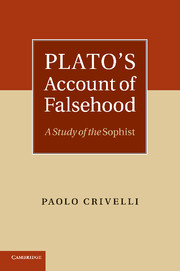Book contents
- Frontmatter
- Contents
- Acknowledgements
- Abbreviations of titles of Plato's works
- Note on the text
- Introduction
- Chapter 1 The sophist defined
- Chapter 2 Puzzles about not-being
- Chapter 3 Puzzles about being
- Chapter 4 The communion of kinds
- Chapter 5 Negation and not-being
- Chapter 6 Sentences, false sentences, and false belief
- Appendix The Sophist on true and false sentences
- References
- Index of names
- Index of subjects
- Index of passages cited
Chapter 6 - Sentences, false sentences, and false belief
Published online by Cambridge University Press: 05 February 2012
- Frontmatter
- Contents
- Acknowledgements
- Abbreviations of titles of Plato's works
- Note on the text
- Introduction
- Chapter 1 The sophist defined
- Chapter 2 Puzzles about not-being
- Chapter 3 Puzzles about being
- Chapter 4 The communion of kinds
- Chapter 5 Negation and not-being
- Chapter 6 Sentences, false sentences, and false belief
- Appendix The Sophist on true and false sentences
- References
- Index of names
- Index of subjects
- Index of passages cited
Summary
Can sentences and beliefs be false? Once the puzzle of not-being has been cracked, the affirmative answer seems irrefragable. But the sophist will raise one more objection: to say, or believe, a falsehood is to say, or believe, what is not; but saying, or believing, what is not is still as impossible and puzzling as it was at the beginning of the discussion that constitutes the Sophist's core. Plato's riposte is to explain saying or believing ‘what is not’ in a way that clearly shows it to be possible. Such an explanation is the target of the last portion of the discussion that constitutes the Sophist's core (259d9–264b5). It divides into three parts, to which the present chapter's three sections correspond.
First, Plato offers an account of sentences (259d9–262e10). Its intent is to show that speaking is a two-pronged activity: whoever speaks says one thing about one thing. Secondly, Plato offers an account of false sentences incorporating the view that whoever speaks falsely says what is not (262e11–263d5). This builds on the result just established: since whoever speaks says one thing about one thing, whoever speaks falsely says what is not by saying about something what is not about it. This is unproblematic because what is not about something is what is different from everything that is about it. Thirdly, Plato offers an account of thought as inner silent conversation (263d6–264b5). This enables him to extend his results from speech to thought.
- Type
- Chapter
- Information
- Plato's Account of FalsehoodA Study of the Sophist, pp. 221 - 260Publisher: Cambridge University PressPrint publication year: 2011



